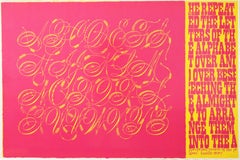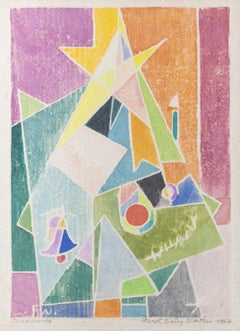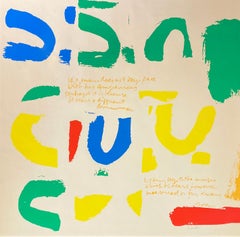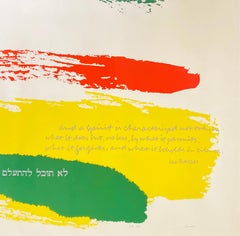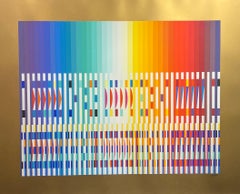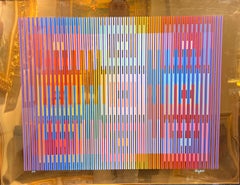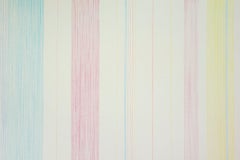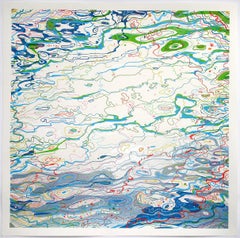Gallery of the Masters More Prints
to
2
6
2
5
Overall Width
to
Overall Height
to
6
6
2
1
5
3
1
1
1
15
2
1
11
2
2
11
2
1
1
1
12
15
He Repeated the Letters of the Alphabet
By Corita Kent
Located in Missouri, MO
Sister Mary Corita Kent (American, 1918-1986)
He Repeated the Letters of the Alphabet...
Color Screenprint
22.5 x 38.75 inches
Signed Lower Right
Sister Mary Corita Kent, once the n...
Category
Mid-20th Century American Modern Abstract Prints
Materials
Color, Screen
Ornaments
Located in Missouri, MO
Ornaments, 1953
Ferol K. Sibley Warthen (American, 1890-1986)
Color Woodblock Print
7 x 4.75 inches
16 x 13.75 inches with frame
Signed and Dated Lower Right
Titled Lower Left
Born 1890, Died 1986...
Category
1950s American Modern Abstract Prints
Materials
Color
Thoreau "If a Man Does Not Keep Peace"
By Corita Kent
Located in Missouri, MO
Thoreau "If a Man Does Not Keep Peace"
Sister Mary Corita Kent (American, 1918-1986)
Signed in Pencil Lower Right
22.5 x 22.5 inches
23.25 x 23.25 inches with frame
Sister Mary Cori...
Category
20th Century American Modern Abstract Prints
Materials
Color, Lithograph
Price Upon Request
Leo Baeck "and a Spirit is Characterized"
By Corita Kent
Located in Missouri, MO
Leo Baeck and a Spirit is Characterized
Sister Mary Corita Kent (American, 1918-1986)
Signed Lower Right in Pencil
Edition of 250 Lower center
21.5 x 21.5 inches
24 x 24 inches frame...
Category
20th Century American Modern Abstract Prints
Materials
Color, Lithograph
Price Upon Request
Spectrum
By Yaacov Agam
Located in Missouri, MO
Spectrum
By. Yaacov Agam (Israeli, b. 1928)
Signed Lower Right
Edition 158/180 Lower Left
Unframed: 27" x 33.5"
Framed: 36.5" x 43"
Yaacov Agam is one of the pioneer creators of the kinetic movement in art as well as its most outstanding contemporary representative. Agam was born in 1928 a son of a Rabbi of Rishon LeZion (Israel), who devoted his life to the study of Jewish religious matters and wrote books. Agam considers himself somehow as a visual continuation of his father's quest for spirituality.
He studied at the Bezalel Academy of Art in Jerusalem, and in Switzerland at the Eidgenossische Technische Hochschule and the Zurich University. After arriving to Paris in 1951, Agam held his first one man exhibition with a great success in 1953 This exhibition consisted totally of kinetic, movable and transformable paintings, which actually was the first one-man show in art history exclusively devoted to kinetic art.
A passionate experimenter, Agam deals with such problems as the 4th dimension, simultaneity and time in the visual, plastic arts, and has extended his experiments to application in the fields of literature, music and art theory.
His works express a concept that breaks away with the established way of expressing reality in limited, static way. In his works, he strives to demonstrate the principle of reality as a continuous "becoming" rather than static "graven image." His paintings Double Metamorphosis 11 in the Museum of Modern Art in New York and Transparent Rhythms 11 in the Hirshhorn Museum and Sculpture Garden of the Smithsonian Institution in Washington, D.C. give the best example of his polymorphic painting. His works are placed in many public places including Communication x 9 on the Michigan Avenue in Chicago (1983), Communication: Night and Day at the AT&T building in New York (1974), Super Lines Volumes at the Pare Floral in Paris (1971), and his murals Peace and Life arc installed at the Parliament of Europe in Strasbourg (1977).
Agam has expressed the new concepts in monumental works as in his Jacob's Ladder, which forms the ceiling of the National Convention House in Jerusalem. He created a "floating museum", including all the artworks for public areas and cabins, for the Carnival Cruise Line's luxury cruise ship "Celebration" (1987). His fire-water fountain in Dizengoff Square in Tel Aviv (1986) streams water, fire, and music -elements of flux and life which cannot be static - as its colored elements rotate in this multidimensional monumental work.
For the Elysee Palace in Paris, with the request of President Georges Pompidou Agam created in 1972 a whole environmental of the Salon with the walls covered with polymorphic murals of changing images a kinetic ceiling, moving transparent colored doors and a kinetic carpet on which he placed a sculpture. It embraces viewers: they are no longer looking at a framed, fixed scene, but rather arc moving within an artistic space which changes constantly according to their shifting position and point of view. Similar attempt was made for the concert hall, Forum Leverkusen in Germany in 1970.
Agam created many environmental sculptures, including Hundred Gates in the garden of the residence of the President of Israel in Jerusalem, 3 x 3 Interplay installed at the Julliard School of Music at the Lincoln Center and Wings of the Heart at J. F. Kennedy airport in New York. In 1984, he made a sculpture Beating Heart for the Hadassah Hospital in Jerusalem. In 1988, he created a transparent torah ark...
Category
20th Century Abstract Abstract Prints
Materials
Lithograph
Price Upon Request
Emerging
By Yaacov Agam
Located in Missouri, MO
Emerging, 1985
By. Yaacov Agam ( Israeli, b. 1928)
Color Serigraph
Signed Lower Right
Edition 1/12 Lower Left
Unframed: 25" x 31"
Framed: 34" x 43"
Yaacov Agam is one of the pioneer creators of the kinetic movement in art as well as its most outstanding contemporary representative. Agam was born in 1928 a son of a Rabbi of Rishon LeZion (Israel), who devoted his life to the study of Jewish religious matters and wrote books. Agam considers himself somehow as a visual continuation of his father's quest for spirituality.
He studied at the Bezalel Academy of Art in Jerusalem, and in Switzerland at the Eidgenossische Technische Hochschule and the Zurich University. After arriving to Paris in 1951, Agam held his first one man exhibition with a great success in 1953 This exhibition consisted totally of kinetic, movable and transformable paintings, which actually was the first one-man show in art history exclusively devoted to kinetic art.
A passionate experimenter, Agam deals with such problems as the 4th dimension, simultaneity and time in the visual, plastic arts, and has extended his experiments to application in the fields of literature, music and art theory.
His works express a concept that breaks away with the established way of expressing reality in limited, static way. In his works, he strives to demonstrate the principle of reality as a continuous "becoming" rather than static "graven image." His paintings Double Metamorphosis 11 in the Museum of Modern Art in New York and Transparent Rhythms 11 in the Hirshhorn Museum and Sculpture Garden of the Smithsonian Institution in Washington, D.C. give the best example of his polymorphic painting. His works are placed in many public places including Communication x 9 on the Michigan Avenue in Chicago (1983), Communication: Night and Day at the AT&T building in New York (1974), Super Lines Volumes at the Pare Floral in Paris (1971), and his murals Peace and Life arc installed at the Parliament of Europe in Strasbourg (1977).
Agam has expressed the new concepts in monumental works as in his Jacob's Ladder, which forms the ceiling of the National Convention House in Jerusalem. He created a "floating museum", including all the artworks for public areas and cabins, for the Carnival Cruise Line's luxury cruise ship "Celebration" (1987). His fire-water fountain in Dizengoff Square in Tel Aviv (1986) streams water, fire, and music -elements of flux and life which cannot be static - as its colored elements rotate in this multidimensional monumental work.
For the Elysee Palace in Paris, with the request of President Georges Pompidou Agam created in 1972 a whole environmental of the Salon with the walls covered with polymorphic murals of changing images a kinetic ceiling, moving transparent colored doors and a kinetic carpet on which he placed a sculpture. It embraces viewers: they are no longer looking at a framed, fixed scene, but rather arc moving within an artistic space which changes constantly according to their shifting position and point of view. Similar attempt was made for the concert hall, Forum Leverkusen in Germany in 1970.
Agam created many environmental sculptures, including Hundred Gates in the garden of the residence of the President of Israel in Jerusalem, 3 x 3 Interplay installed at the Julliard School of Music at the Lincoln Center and Wings of the Heart at J. F. Kennedy airport in New York. In 1984, he made a sculpture Beating Heart for the Hadassah Hospital in Jerusalem. In 1988, he created a transparent torah ark...
Category
20th Century Abstract Abstract Prints
Materials
Lithograph
Price Upon Request
Curtain
By Yaacov Agam
Located in Missouri, MO
Curtain
By. Yaacov Agam (Israeli, b. 1928)
Signed Lower Right
Edition 221/227
Unframed: 18" x 22.5"
Framed: 30.5" x 34.5"
Yaacov Agam is one of the pioneer creators of the kinetic movement in art as well as its most outstanding contemporary representative. Agam was born in 1928 a son of a Rabbi of Rishon LeZion (Israel), who devoted his life to the study of Jewish religious matters and wrote books. Agam considers himself somehow as a visual continuation of his father's quest for spirituality.
He studied at the Bezalel Academy of Art in Jerusalem, and in Switzerland at the Eidgenossische Technische Hochschule and the Zurich University. After arriving to Paris in 1951, Agam held his first one man exhibition with a great success in 1953 This exhibition consisted totally of kinetic, movable and transformable paintings, which actually was the first one-man show in art history exclusively devoted to kinetic art.
A passionate experimenter, Agam deals with such problems as the 4th dimension, simultaneity and time in the visual, plastic arts, and has extended his experiments to application in the fields of literature, music and art theory.
His works express a concept that breaks away with the established way of expressing reality in limited, static way. In his works, he strives to demonstrate the principle of reality as a continuous "becoming" rather than static "graven image." His paintings Double Metamorphosis 11 in the Museum of Modern Art in New York and Transparent Rhythms 11 in the Hirshhorn Museum and Sculpture Garden of the Smithsonian Institution in Washington, D.C. give the best example of his polymorphic painting. His works are placed in many public places including Communication x 9 on the Michigan Avenue in Chicago (1983), Communication: Night and Day at the AT&T building in New York (1974), Super Lines Volumes at the Pare Floral in Paris (1971), and his murals Peace and Life arc installed at the Parliament of Europe in Strasbourg (1977).
Agam has expressed the new concepts in monumental works as in his Jacob's Ladder, which forms the ceiling of the National Convention House in Jerusalem. He created a "floating museum", including all the artworks for public areas and cabins, for the Carnival Cruise Line's luxury cruise ship "Celebration" (1987). His fire-water fountain in Dizengoff Square in Tel Aviv (1986) streams water, fire, and music -elements of flux and life which cannot be static - as its colored elements rotate in this multidimensional monumental work.
For the Elysee Palace in Paris, with the request of President Georges Pompidou Agam created in 1972 a whole environmental of the Salon with the walls covered with polymorphic murals of changing images a kinetic ceiling, moving transparent colored doors and a kinetic carpet on which he placed a sculpture. It embraces viewers: they are no longer looking at a framed, fixed scene, but rather arc moving within an artistic space which changes constantly according to their shifting position and point of view. Similar attempt was made for the concert hall, Forum Leverkusen in Germany in 1970.
Agam created many environmental sculptures, including Hundred Gates in the garden of the residence of the President of Israel in Jerusalem, 3 x 3 Interplay installed at the Julliard School of Music at the Lincoln Center and Wings of the Heart at J. F. Kennedy airport in New York. In 1984, he made a sculpture Beating Heart for the Hadassah Hospital in Jerusalem. In 1988, he created a transparent torah ark...
Category
20th Century Abstract Abstract Prints
Materials
Lithograph
Price Upon Request
Blue Rings (Abstract Composition)
By Yaacov Agam
Located in Missouri, MO
Blue Rings (Abstract Composition), Serigraph
By Yaacov Agam (Israeli, b. 1928)
Signed Lower Right
Edition 8/270 Lower Left
Unframed: 21" x 21.5"
Framed: 31" ...
Category
20th Century Abstract Abstract Prints
Materials
Lithograph
Price Upon Request
Abstract Purple, Blue, Greens
By Yaacov Agam
Located in Missouri, MO
Abstract Purple, Blue, Greens (Serigraph)
By Yaacov Agam (Israeli, b. 1928)
Signed Lower Right
Edition 4/30 Lower Left
Unframed: 14" x 33"
Framed: 21" x 41"
Yaacov Agam is one of the pioneer creators of the kinetic movement in art as well as its most outstanding contemporary representative. Agam was born in 1928 a son of a Rabbi of Rishon LeZion (Israel), who devoted his life to the study of Jewish religious matters and wrote books. Agam considers himself somehow as a visual continuation of his father's quest for spirituality.
He studied at the Bezalel Academy of Art in Jerusalem, and in Switzerland at the Eidgenossische Technische Hochschule and the Zurich University. After arriving to Paris in 1951, Agam held his first one man exhibition with a great success in 1953 This exhibition consisted totally of kinetic, movable and transformable paintings, which actually was the first one-man show in art history exclusively devoted to kinetic art.
A passionate experimenter, Agam deals with such problems as the 4th dimension, simultaneity and time in the visual, plastic arts, and has extended his experiments to application in the fields of literature, music and art theory.
His works express a concept that breaks away with the established way of expressing reality in limited, static way. In his works, he strives to demonstrate the principle of reality as a continuous "becoming" rather than static "graven image." His paintings Double Metamorphosis 11 in the Museum of Modern Art in New York and Transparent Rhythms 11 in the Hirshhorn Museum and Sculpture Garden of the Smithsonian Institution in Washington, D.C. give the best example of his polymorphic painting. His works are placed in many public places including Communication x 9 on the Michigan Avenue in Chicago (1983), Communication: Night and Day at the AT&T building in New York (1974), Super Lines Volumes at the Pare Floral in Paris (1971), and his murals Peace and Life arc installed at the Parliament of Europe in Strasbourg (1977).
Agam has expressed the new concepts in monumental works as in his Jacob's Ladder, which forms the ceiling of the National Convention House in Jerusalem. He created a "floating museum", including all the artworks for public areas and cabins, for the Carnival Cruise Line's luxury cruise ship "Celebration" (1987). His fire-water fountain in Dizengoff Square in Tel Aviv (1986) streams water, fire, and music -elements of flux and life which cannot be static - as its colored elements rotate in this multidimensional monumental work.
For the Elysee Palace in Paris, with the request of President Georges Pompidou Agam created in 1972 a whole environmental of the Salon with the walls covered with polymorphic murals of changing images a kinetic ceiling, moving transparent colored doors and a kinetic carpet on which he placed a sculpture. It embraces viewers: they are no longer looking at a framed, fixed scene, but rather arc moving within an artistic space which changes constantly according to their shifting position and point of view. Similar attempt was made for the concert hall, Forum Leverkusen in Germany in 1970.
Agam created many environmental sculptures, including Hundred Gates in the garden of the residence of the President of Israel in Jerusalem, 3 x 3 Interplay installed at the Julliard School of Music at the Lincoln Center and Wings of the Heart at J. F. Kennedy airport in New York. In 1984, he made a sculpture Beating Heart for the Hadassah Hospital in Jerusalem. In 1988, he created a transparent torah ark...
Category
20th Century Abstract Abstract Prints
Materials
Lithograph
Price Upon Request
Colossal Flashlight in Place of Hoover Dam
By Claes Oldenburg
Located in Missouri, MO
Colossal Flashlight in Place of Hoover Dam, 1982
By Claes Oldenburg (Swedish, American, 1929-2022)
Signed Lower Right
Dated Middle Right
Unframed: 23" x 22"
Framed: 36.5" x 27.5"
Whimsical sculpture of pop culture objects, many of them large and out-of-doors, is the signature work of Swedish-born Claes Oldenburg who became one of America's leading Pop Artists. He was born in Stockholm, Sweden. His father was a diplomat, and during Claes' childhood moved his family from Stockholm to a variety of locations including Chicago where the father was general consul of Sweden and where Oldenburg spent most of his childhood. He attended the Latin School of Chicago, and then Yale University where he studied literature and art history, graduating in 1950, the same year Claes became an American citizen.
Returning to Chicago, he enrolled at the Art Institute of Chicago from 1952 to 1954 and also worked as a reporter at the City News Bureau. He opened his own studio, and in 1953, some of his satirical drawings were included in his first group show at the Club St. Elmo, Chicago. He also painted at the Oxbow School of Painting in Michigan.
In 1956, he moved to New York where he drew and painted while working as a clerk in the art libraries of Cooper-Union Museum for the Arts of Decoration. Selling his first artworks during this time, he earned 25 dollars for five pieces.
Oldenburg became friends with numerous artists including Jim Dine, Red Grooms and Allan Kaprow, who with his "Happenings" was especially influential on Oldenburg's interest in environmental art. Another growing interest was soft sculpture, and in 1957, he created a piece later titled Sausage, a free-hanging woman's stocking stuffed with newspaper.
In 1959, he had his first one-man show, held at the Judson Gallery at Washington Square. He exhibited wood and newspaper sculpture and painted papier-mache objects. Some viewers of the exhibit commented how refreshing Oldenburg's pieces were in contrast to the Abstract Expressionism, a style which much dominated the art world. During this time, he was influenced by the whimsical work of French artist, Bernard Buffet, and he experimented with materials and images of the junk-filled streets of New York.
In 1960, Oldenburg created his first Pop-Art Environments and Happenings in a mock store full of plaster objects. He also did Performances with a cast of colleagues including artists Lucas Samaras, Tom Wesselman, Carolee Schneemann, Oyvind Fahlstrom and Richard Artschwager, dealer Annina Nosei, critic Barbara Rose, and screenwriter Rudy Wurlitzer.
His first wife (1960-1970) Pat Muschinski, who sewed many of his early soft sculptures, was a constant performer in his Happenings. This brash, often humorous, approach to art was at great odds with the prevailing sensibility that, by its nature, art dealt with "profound" expressions or ideas.
In December 1961, he rented a store on Manhattan's Lower East Side to house "The Store," a month-long installation he had first presented at the Martha Jackson Gallery in New York. This installation was stocked with sculptures roughly in the form of consumer goods.
Oldenburg moved to Los Angeles in 1963 "because it was the most opposite thing to New York I could think of". That same year, he conceived AUT OBO DYS, performed in the parking lot of the American Institute of Aeronautics and Astronautics in December 1963.
In 1965 he turned his attention to drawings and projects for imaginary outdoor monuments. Initially these monuments took the form of small collages such as a crayon image of a fat, fuzzy teddy bear looming over the grassy fields of New York's Central Park (1965) and Lipsticks in Piccadilly Circus, London (1966). Oldenburg realized his first outdoor public monument in 1967; Placid Civic Monument took the form of a Conceptual performance/action behind the Metropolitan Museum of Art, New York, with a crew of gravediggers digging a 6-by-3-foot rectangular hole in the ground.
Many of Oldenburg's large-scale sculptures of mundane objects elicited public ridicule before being embraced as whimsical, insightful, and fun additions to public outdoor art. From the early 1970s Oldenburg concentrated almost exclusively on public commissions.
Between 1969 and 1977 Oldenburg had been in a relationship with Hannah Wilke, feminist artist, but in 1977 he married Coosje van Bruggen, a Dutch-American writer and art historian who became collaborator with him on his artwork. He had met her in 1970, when she curated an exhibition for him at the Stedelijk Museum in Amsterdam. Their first collaboration came when Oldenburg was commissioned to rework Trowel I, a 1971 sculpture of an oversize garden tool, for the grounds of the Kröller-Müller Museum in Otterlo, the Netherlands.
Oldenburg has officially signed all the work he has done since 1981 with both his own name and van Bruggen's. In 1988, the two created the iconic Spoonbridge and Cherry sculpture for the Walker Art Center in Minneapolis, Minnesota that remains a staple of the Minneapolis Sculpture Garden as well as a classic image of the city. Typewriter Eraser...
Category
20th Century American Modern Abstract Prints
Materials
Paper, Lithograph
Price Upon Request
Fodder
By John Costigan
Located in Missouri, MO
Fodder by John Costigan (1888-1972)
Signed Lower Right
Titled Lower Left
9.75" x 12.75" Unframed
17.5" x 19.75" Framed
John Edwards Costigan was born in Providence, Rhode Island on ...
Category
20th Century American Impressionist Landscape Prints
Materials
Etching
Price Upon Request
Observador de Pajaros
By Rufino Tamayo
Located in Missouri, MO
"Observador de Pajaros" 1950
By. Rufino Tamayo (Mexican, 1899-1991)
Edition 83/200 Lower Right
Signed Lower Left
Unframed: 15.5" x 22.5"
Framed: 21.75" x 28.25"
Rufino Tamayo (August 26, 1899- June 24, 1991)
A native of Oaxaca in Southern Mexico, Rufino Tamayo's father was a shoemaker, and his mother a seamstress. Some accounts state that he was descended from Zapotec Indians, but he was actually 'mestizo' - of mixed indigenous/European ancestry. (Santa Barbara Museum of Art). He began painting at age 11. Orphaned at the age of 12, Tamayo moved to Mexico City, where he was raised by his maternal aunt who owned a wholesale fruit business.
In 1917, he entered the San Carlos Academy of Fine Arts, but left soon after to pursue independent study. Four years later, Tamayo was appointed the head designer of the department of ethnographic drawings at the National Museum of Archaeology in Mexico City. There he was surrounded by pre-Colombian objects, an aesthetic inspiration that would play a pivotal role in his life. In his own work, Tamayo integrated the forms and tones of pre-Columbian ceramics into his early still lives and portraits of Mexican men and women.
In the early 1920s he also taught art classes in Mexico City's public schools. Despite his involvement in Mexican history, he did not subscribe to the idea of art as nationalistic propaganda. Modern Mexican art at that time was dominated by 'The Three Great Ones' : Diego Rivera, Jose Clemente Orozco, and David Alfaro Siqueros, but Tamayo began to be noted as someone 'new' and different' for his blending of the aesthetics of post Revolutionary Mexico with the vanguard artists of Europe and the United States.
After the Mexican Revolution, he focused on creating his own identity in his work, expressing what he thought was the traditional Mexico, and refusing to follow the political trends of his contemporary artists. This caused some to see him as a 'traitor' to the political cause, and he felt it difficult to freely express himself in his art. As a result, he decided to leave Mexico in 1926 and move to New York, along with his friend, the composer Carlos Chavez. The first exhibition of Tamayo's work in the United States was held at the Weyhe Gallery, New York, in that same year. The show was successful, and Tamayo was praised for his 'authentic' status as a Mexican of 'indigenous heritage', and for his internationally appealing Modernist aesthetic. (Santa Barbara Museum of Art).
Throughout the late thirties and early forties New York's Valentine Gallery gave him shows. For nine years, beginning in 1938, he taught at the Dalton School in New York.
In 1929, some health problems led him to return to Mexico for treatment. While there he took a series of teaching jobs. During this period he became romantically involved with the artist Maria...
Category
20th Century Abstract Abstract Prints
Materials
Lithograph
Price Upon Request
Les Grandes Voiles (The Grand Sails)
By Marcel Mouly
Located in Missouri, MO
Hand-Signed by the Artist Lower Right
Titled Lower Center
Inscribed "Epreuve d'Artist" (Artist's Proof) Lower Left
Framed: 25.5 x 32.75 inches
Site Size: 19 x 26.5 inches
Marcel Mou...
Category
Late 20th Century Modern More Prints
Materials
Lithograph
Price Upon Request
One of Diamond and Thirteen of Diamonds
By Donald Sultan
Located in Missouri, MO
"One of Diamonds and Thirteen of Diamonds" (from Playing Cards) 1990
Aquatint Engravings Framed Together
Each Signed, Titled and Dated
Each Numbered Lower ...
Category
1990s Pop Art More Prints
Materials
Engraving, Aquatint
Price Upon Request
Montmartre at Sacre Coeur
By Jean Dufy
Located in Missouri, MO
Jean Dufy
"Montmartre et La Basilique du Sacre Coeur" c. 1950s
Color Lithograph
Signed in Pencil Lower Right
Numbered 78/250 Lower Left
Image Size: approx...
Category
1950s Impressionist Landscape Prints
Materials
Lithograph
Price Upon Request
Related Items
Ferris Wheel: abstract modern minimalist color field drawing with rainbow colors
By Gene Davis
Located in New York, NY
This geometric, minimalist print glows in rainbow shades. Vibrant raspberry pink, magenta, yellow, lime green, and sky-blue lines take on the organic quality of handmade paper, resul...
Category
1970s Abstract Abstract Prints
Materials
Lithograph
$1,350
H 30.25 in W 39.75 in
Ripples of Colour, Art print, Abstract, Water, Line art, Blue green, red, white
By Chris Keegan
Located in Deddington, GB
This is a Five colour screen print Including a metallic Silver layer. This print is then finished off by drawing over the print with multi-coloured paint including Gold, Yellow and G...
Category
2010s Abstract Abstract Prints
Materials
Paper, Screen
$413
H 21.93 in W 22.05 in D 0.04 in
Moment of Silence
By Mr Brainwash
Located in London, GB
6-Colour Screen Print on Archival Paper
hand-signed and numbered by the artist
57.2 cm x 57.2 cm
Edition 108 of 150
Artwork by Mr. Brainwash, (the pseudonym of French-born artist ...
Category
2010s Street Art Abstract Prints
Materials
Archival Paper, Screen
Horizon VI (blue, purple, green)
By Richard Smith
Located in London, GB
Edition of 75, Set of 6
33 x 71 cms (13 x 28 ins)
Category
1970s Abstract Abstract Prints
Materials
Lithograph
Addison Gallery 1982 SIGNED Frank Stella Vintage Poster, metallic rainbow
By Frank Stella
Located in New York, NY
This shimmering, metallic vintage poster with rainbow text and layers of texture must be seen in person to appreciate Frank Stella's masterful design. Original exhibition poster for Frank Stella’s Metal Reliefs exhibition at the Addison Gallery...
Category
Late 20th Century Abstract Abstract Prints
Materials
Lithograph
Octavio Paz Suite: Nocturne VI
By Robert Motherwell
Located in London, GB
Lithograph and chine appliqué
64.5 x 54 cms (25 3/8 x 21 1/4 ins)
Edition 50
Paper: Arches paper; Japanese Gampi handmade paper
Other Collaborators: Image transferred from Mylar to...
Category
1980s Abstract Expressionist Abstract Prints
Materials
Handmade Paper, Color, Lithograph
Tropic Fruit
By Howard Hodgkin
Located in London, GB
80 x 94 cms (31.5 x 37 ins)
Edition of 100
Category
1980s Abstract Abstract Prints
Materials
Color, Screen
Marc Chagall - Cover - Original Lithograph
By Marc Chagall
Located in Collonge Bellerive, Geneve, CH
Marc Chagall - Cover - Original Lithograph
1964
Dimensions: 30 x 20 cm
Edition of 200 (one of the 200 on Vélin de Rives)
Mourlot Press, 1964
Marc Chagall (born in 1887)
Marc Chaga...
Category
1960s Modern Abstract Prints
Materials
Lithograph
Abstract Expressionist Lithograph for the Carnegie Museum of Art, Lt Ed. of 1000
By Joan Mitchell
Located in New York, NY
Joan Mitchell
Untitled Abstract Expressionist Print for the Carnegie Museum of Art, 1972
Lithograph on wove paper
15 × 22 inches
Limited Edition of 1000 (unnumbered)
Printer: Maeght...
Category
1970s Abstract Expressionist Abstract Prints
Materials
Lithograph
Les Amoureux- From the Album "Jean Cocteau Lithographies" by Jean Cocteau
By Jean Cocteau
Located in New York, NY
The modern lithograph "Les Amoureux" by Jean Cocteau was printed at the Atelier Mourlot in 1957. Cocteau was a master at representing the languid forms of his subjects in sketches. H...
Category
1950s Modern Abstract Prints
Materials
Lithograph
$952 Sale Price
20% Off
H 25.5 in W 19.75 in
A Paintings Retrospective: vintage LACMA Museum poster depicting her 1963 work
By Helen Frankenthaler
Located in New York, NY
Helen Frankenthaler (after)
A Paintings Retrospective: vintage LACMA Museum poster, 1990
Offset lithograph museum poster
(Unsigned & Unnumbered)
37 × 25 inches
Unframed
This was printed in the artists lifetime - making it more collectible - on the occasion of the exhibition, "Helen Frankenthaler: A Paintings Retrospective from February to April, 1990 at the Los Angeles County Museum of Art (LACMA)
Print is published by Editions Limited Galleries, San Francisco for Los Angeles County Museum of Art (LACMA), LA, CA
The work depicted is Helen Frankenthaler, The Bay, 1963, acrylic on canvas, Detroit Institute of Arts, Michigan (Incidentally, this beautiful work is featured on the cover of the book Water and Art' by David Clarke.)
“What concerns me when I work is not whether a picture is a landscape… or whether somebody will see a sunset in it. What concerns me is, did I make a beautiful picture?” - - Helen Frankenthaler
This is Frankenthaler's first silkscreen, produced for the portfolio New York Ten, which includes works by other New York-based artists at the time such as Roy Lichtenstein, Jim Dine, Tom Wesselmann and Claes Oldenburg. (She created her first lithograph in 1961)
Other examples of this edition are found in the permanent collections of the Museum of Modern Art, MOCA Chicago, the Metropolitan Museum, the Philadelphia Museum, the Art Institute of Chicago, and numerous regional museums and institutions in the United States and worldwide.
Helen Frankenthaler, A Brief Biography
Helen Frankenthaler (1928-2011), whose career spanned six decades, has long been recognized as one of the great American artists of the twentieth century. She was eminent among the second generation of postwar American abstract painters and is widely credited for playing a pivotal role in the transition from Abstract Expressionism to Color Field painting. Through her invention of the soak-stain technique, she expanded the possibilities of abstract painting, while at times referencing figuration and landscape in unique ways. She produced a body of work whose impact on contemporary art has been profound and continues to grow.
Frankenthaler was born on December 12, 1928, and raised in New York City. She attended the Dalton School, where she received her earliest art instruction from Rufino Tamayo. In 1949 she graduated from Bennington College, Vermont, where she was a student of Paul Feeley. She later studied briefly with Hans Hofmann.
Frankenthaler’s professional exhibition career began in 1950, when Adolph Gottlieb selected her painting Beach (1950) for inclusion in the exhibition titled Fifteen Unknowns: Selected by Artists of the Kootz Gallery. Her first solo exhibition was presented in 1951, at New York’s Tibor de Nagy Gallery, and that year she was also included in the landmark exhibition 9th St. Exhibition of Paintings and Sculpture.
In 1952 Frankenthaler created Mountains and Sea, a breakthrough painting of American abstraction for which she poured thinned paint directly onto raw, unprimed canvas laid on the studio floor, working from all sides to create floating fields of translucent color. Mountains and Sea was immediately influential for the artists who formed the Color Field school of painting, notable among them Morris Louis and Kenneth Noland.
As early as 1959, Frankenthaler began to be a regular presence in major international exhibitions. She won first prize at the Premiere Biennale de Paris that year, and in 1966 she represented the United States in the 33rd Venice Biennale, alongside Ellsworth Kelly, Roy Lichtenstein, and Jules Olitski. She had her first major museum exhibition in 1960, at New York’s Jewish Museum, and her second, in 1969, at the Whitney Museum of American Art, followed by an international tour.
Frankenthaler experimented tirelessly throughout her long career. In addition to producing unique paintings on canvas and paper, she worked in a wide range of media, including ceramics, sculpture, tapestry, and especially printmaking. Hers was a significant voice in the mid-century “print renaissance” among American abstract painters, and she is particularly renowned for her woodcuts. She continued working productively through the opening years of this century.
Frankenthaler’s distinguished, prolific career has been the subject of numerous monographic museum exhibitions. The Jewish Museum and Whitney Museum shows were succeeded by a major retrospective initiated by the Modern Art Museum of Fort Worth that traveled to The Museum of Modern Art, New York, the Los Angeles County Museum of Art, and the Detroit Institute of Arts, MI (1989); and those devoted to works on paper and prints organized by the National Gallery of Art, Washington, D.C. (1993), among others.
Select recent important exhibitions have included Painted on 21st Street: Helen Frankenthaler from 1950 to 1959 (Gagosian, NY, 2013); Making Painting: Helen Frankenthaler and JMW Turner (Turner Contemporary, Margate, UK, 2014); Giving Up One’s Mark: Helen Frankenthaler in the 1960s and 1970s (Albright-Knox Art Gallery, Buffalo, NY, 2014–15); Pretty Raw: After and Around Helen Frankenthaler (Rose Art Museum, Brandeis University, Waltham, MA, 2015); As in Nature: Helen Frankenthaler, Paintings and No Rules: Helen Frankenthaler Woodcuts...
Category
1990s Abstract Expressionist Abstract Prints
Materials
Offset, Lithograph
The Darker Palette print, Hand signed twice and inscribed by Helen Frankenthaler
By Helen Frankenthaler
Located in New York, NY
Helen Frankenthaler (after)
Frankenthaler: The Darker Palette (autographed and inscribed), 1998
Offset Lithograph print
42 × 35 in
hand signed "Frankenthaler" lower left; inscribed a...
Category
1990s Abstract Expressionist Abstract Prints
Materials
Offset, Lithograph
